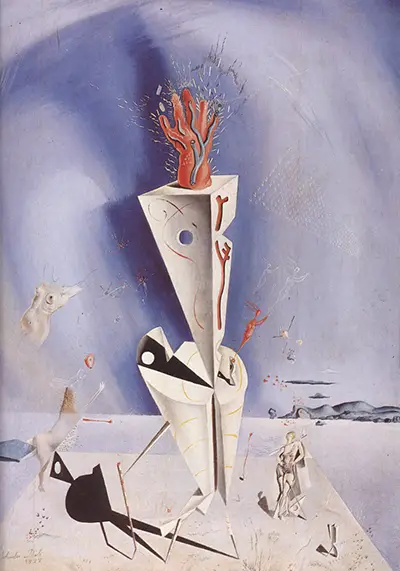This surrealistic artwork displays a geometric figure that has a tumescent red hand that is seen protruding from its head. This figure is composed of triangles and cones. Surrounding the structure are nude female figures, ghostly images and torsos that are superimposed on a blue and watery dreamscape. The piece was done upon Salvador return from nine months of military duty. During his military career, Salvador started to experiment with new subjects that he had not used before for his work.
In the title, the Apparatus refers to that geometric figure structured like the human form. Looking at the figure, it has analogues of human legs, arms, a head and an eye. The hand on the top of the figure's head in the painting is a reference to masturbation (Onanism), which used to be a common theme in the artist's work at the time. The triangular being pops up on what seems to be a cane, a leitmotif in Salvador's work that represents the fragility of sleep. This period of Salvador's is called the Freudian Period, which was during the historical Avant-Garde movement. This was weighted heavily on Freud's writings.
The female images that surround the geometric figure are illustrative of thoughts that are within the Apparatus' mind. The images represent the artist's delirious erotic thought processes, which was a prevailing theme of the artist's work as well. On the right side of the structure, there's a classically posed female set in contrast to the centre image geometric simplicity. The image of a donkey standing on its hind legs is seen to the left side of the geometric figure. A horde of flies consume the donkey, and they are attacking its belly. That's indicative of the creature's decomposition. Salvador has been mentioned as a major inspiration by numerous modern artists, such as Jeff Koons, Damien Hirst plus most other modern surrealists. Robert Pattinson portrayed the artist in Little Ashes (a 2008 film) and Adrien Brody also portrayed him in the 2011 film Midnight in Paris.

